The penultimate part of the series takes us north, from Badami to Bijapur and then on to Gulbarga. Northern Karnataka has a higher proportion of Muslim inhabitants than most other parts of the state and there is a preponderance of sights which also have an association with Islam, such as mosques and tombs of Muslim rulers. Most of these have their origin in the period of the Deccan Sultanates (16th and 17th centuries), with a few dating back to the earlier times of the Bahamani Sultanate (from the middle of the 14th century onwards).
The drive from Badami to Bijapur covers no great distance, but roadworks just outside Badami resulted in us literally going round in circles for a while. Rathan, our driver, relied on his satellite navigation system to find the way after the roadworks had forced us off the planned route. We all got a little concerned when the automated voice kept on telling us to “turn right” whenever we had an option – and, lo and behold, after driving down various unlikely looking roads we ended up virtually where we had started. By asking around we eventually found a sign saying ‘Bijapur’ – or rather ‘Vijayapura’, which is the city’s old/new name in Kannada (see Pt.1) – and to our relief the next one we came across showed that the distance had decreased.
The countryside we went through was pleasant, without being particularly exciting. However, we enjoyed the little markets we occasionally went past.
In the end we reached Bijapur with enough time to spare for a couple of hours’ exploration before sunset. A pre-arranged guided tour the next morning would show us the main sights, but our guidebooks told us that there were at least two additional places worth seeing within a fairly short distance from the hotel. We thought that Rathan deserved a rest and opted for a tuk-tuk ride. The nearest place of interest was the Asar Mahal, built in the mid-17th century by the then ruler of Bijapur, Mohammed Adil Shah.
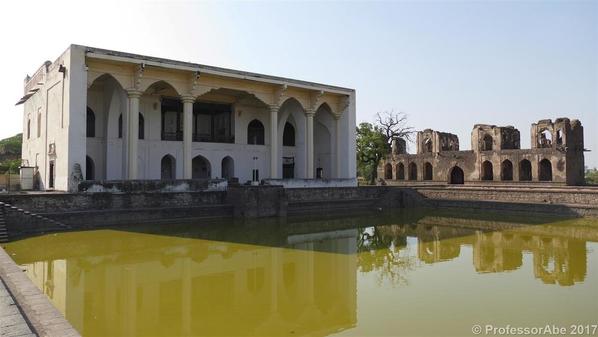
Its original purpose apparently was to serve as a hall of justice, but it also seems to have acquired a religious significance through the fact that it housed important relics. We took the photo above, but did not stay long. What you cannot make out in the photo is the large amount of rubbish that has been dumped into the tank.
A more enjoyable experience was our visit to the Bara Kaman. This is the (unfinished) mausoleum of Ali Adil Shah II, the son of Mohammed Adil Shah, and the two photos below show different views of this interesting structure.
Some guidebooks and internet sources claim that the original plan involved “placing twelve arches vertically as well as horizontally” – the wording used is nearly always the same – and that this grandiose building was prevented from being completed because it would have outshone other mausoleums, notably the Gol Gumbaz (depicted at the beginning of this piece and further down). However, when you look at the structure, it is obvious that there were never more than seven arches either along the length or the width and it is equally obvious that the foundations on which they stand do not allow room for further arches. There are also claims that Ali Adil Shah II was murdered by his own father over the mausoleum controversy. According to the history books, however, the father passed away some 15 years before the son, making the murder a physical impossibility. Whatever the truth might be, Ali Adil Shah II died before the Bara Kaman was finished and his tomb lies at the centre of the mausoleum, along with those of members of his family.
Our hotel in Bijapur was fairly central and quite modern, but also very unwelcoming and noisy. It was easily the worst hotel of the whole trip and we had no desire to linger there the next morning. We were, therefore, pleased when our guide arrived somewhat earlier than originally arranged.
The natural starting point for the tour was the Gol Gumbaz, Mohammed Adil Shah’s mausoleum and Bijapur’s most famous landmark. In the photo at the top of this piece it looks as if the dark brown building in the foreground is attached to the dome. However, when you get closer you realise that it is some distance away from the huge edifice behind it. Below is a photo of the actual mausoleum.
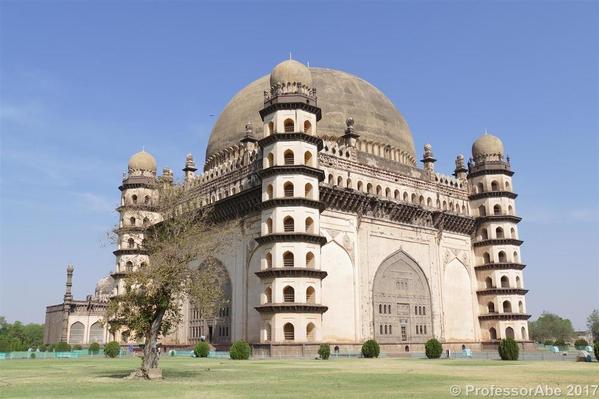
The dome, which measures 43m in diameter externally, is said to be the second largest in the world, after St. Peter’s cathedral in Rome. There are no internal pillars supporting it.
The interior is very plain, almost disappointingly so – the Gol Gumbaz took decades to construct, but Mohammed Adil Shah also died before his mausoleum was properly finished. His tomb sits in the middle of the building, below the cenotaph shown in the next photo.
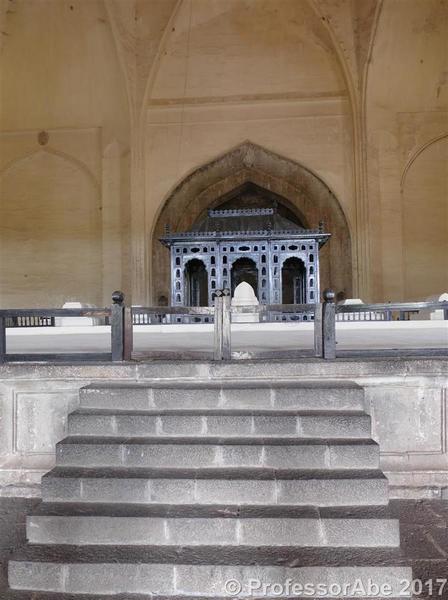
There is a ‘Whispering Gallery’ around the inside base of the dome, from where even quiet sounds can be heard clearly on the other side. It is also possible to walk around the base of the dome on the outside. My wife went up with the guide, but my fear of heights left me firmly on the ground (taking photos).
Next to the Gol Gumbaz is a mosque, but it is not open to visitors.
It was very quiet when we first got to the site. When we were getting ready to leave, however, literally hundreds of youngsters suddenly arrived and my wife was quickly surrounded by a throng of people who wanted a photo with her.

Several times each day we were approached by strangers who asked whether they could have a photo of/with us – on occasion they were happy for us simply to take a photo of them. (We had similar experiences in other parts of India, although not quite as frequently. The attraction seems to be the very fact that we are foreigners, but I cannot quite get my head around the phenomenon.)
Next up on our agenda was the Jama Masjid, a large mosque built in the 16th century. It is said to be able to accommodate up to 2500 worshippers.
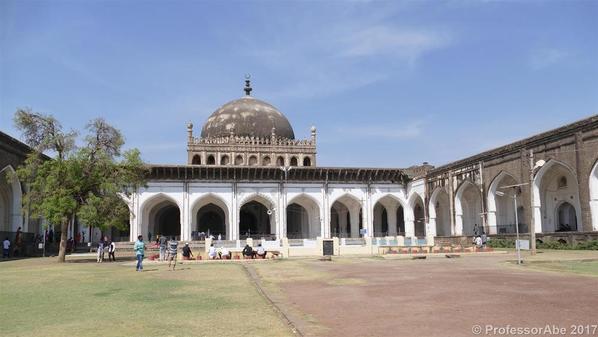
For the most part the interior is fairly plain. The mihrab arch, however, is quite ornate.
It is interesting to note that the theme encountered earlier in connection with the Bara Kaman and then the Gol Gumbaz is continued here: the mosque was never fully completed.
Bijapur has seen many battles over the centuries. One of the key sights is a massive cannon, which sits in a bastion on the city’s fortifications. The cannon dates from the middle of the 16th century and is supposed to weigh 55 tons. Its muzzle is highly unusual, in that it is shaped in the form of a lion head with open jaws.
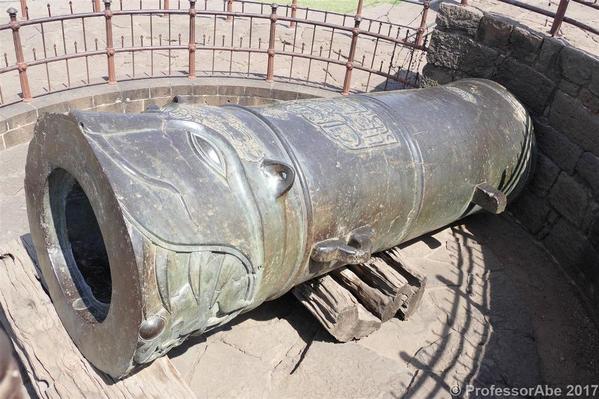
The final stop on our city tour was the Ibrahim Rauza, built by Ibraham Adil Shah II in the 17th century as a mausoleum for his wife. He actually died before her and is also buried there. Opposite the mausoleum is a mosque of almost the same size and built in a similar style. The two are separated by a tank and the whole complex is surrounded by a rectangular wall. The photo below shows the approach to the site.
The building on the left of the shot is the mausoleum. The next two photos also show the mausoleum, once from a corner of the site and then through the central arch of the mosque.
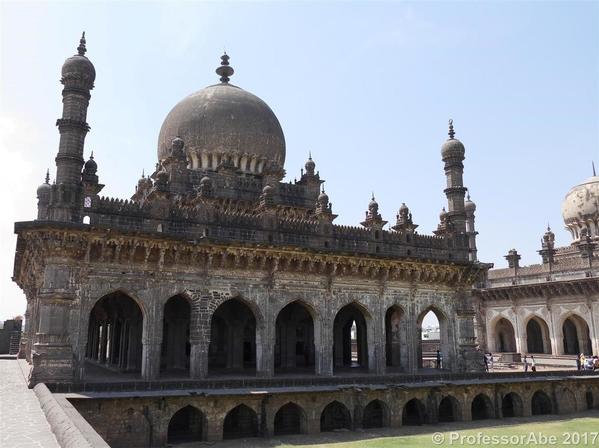
The mosque itself can be seen below.

It is said that Shah Jahan, the builder of Agra’s Taj Mahal, drew on the Ibrahim Rauza for inspiration.
The mausoleum is not only the larger, but the more ornate building of the two. The exterior walls of the sepulchral chamber are embellished with elaborate carvings.
Below the large platform on which both the mausoleum and the mosque sit is a warren of archways, which we explored for a while – the shade was very welcome, particularly as midday was approaching by then.
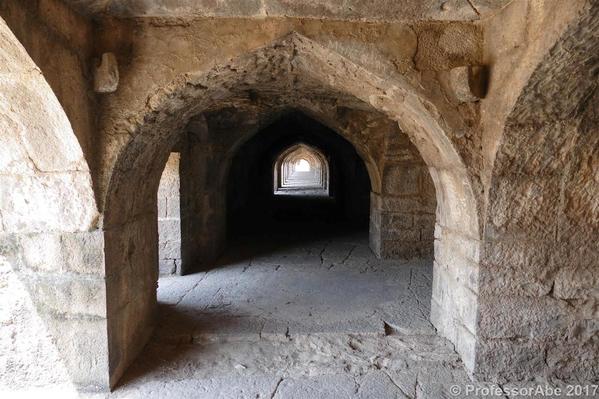
After sampling some delicious savoury pastries at a bakery which our guide had recommended, we set off for Gulbarga (now also known as Kalaburagi, although there seems to be some ongoing local controversy about the name change).
We got the impression that cotton was the main agricultural product of the area we drove through. Loading it onto a lorry is not an easy task.

On the journey we also caught sight of the rare blue-horned Indian ox.
Gulbarga today is an unremarkable town, but it once was the capital of the Bahamani sultans. Its most famous sight is probably its fort, which covers a large area on the edge of the town. Much of the outside wall is still standing, but what is left of the rest is far from impressive. The next photo shows the entrance to the largest bastion that has remained.

Within the fortifications is the large Jama Masjid, pictured below.

It clearly had seen better days, but finally seemed to be getting some much needed attention. At least that was the impression we got from the heaps of sand, cement and other building materials which occupied much of the prayer hall when we ventured inside.
Having looked around the fort, we went on to a site known as Haft Gumbaz. A sign by the entrance translated that as ‘Seven Domes’, which is exactly what you see in front of you when you come in. The domed structures are the mausoleums of various Bahamani rulers.
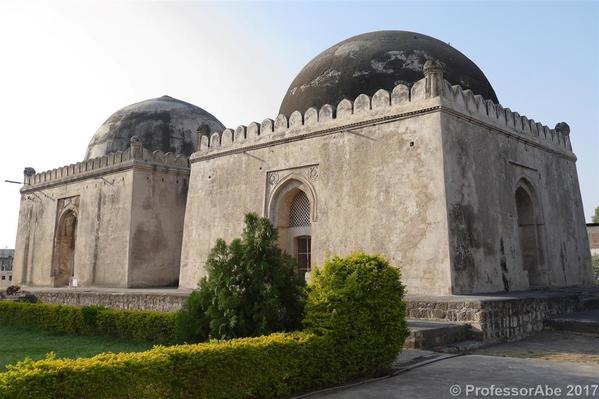
Some of the buildings clearly once had elaborate ornamentation on the inside, but not much of the original splendour remains.

The actual tombs are very plain.
Gulbarga does not receive a lot of foreign visitors and I doubt whether many of them come to this site. Indeed, I do not believe that many Indians visit it either. However, we felt privileged to be shown round here and would certainly recommend coming.
If bird-watching is more your thing: there are quite a few parakeets around the site ...
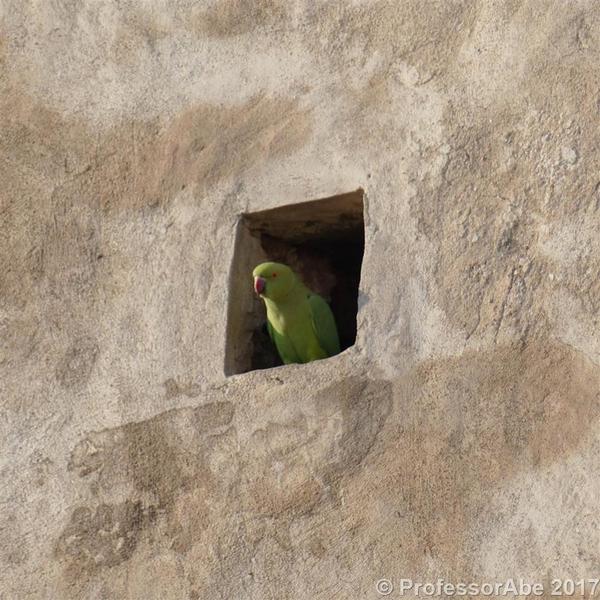
… and when we returned to the hotel, we found a large group of black-headed ibises sitting on the ramparts of the fort opposite our balcony.
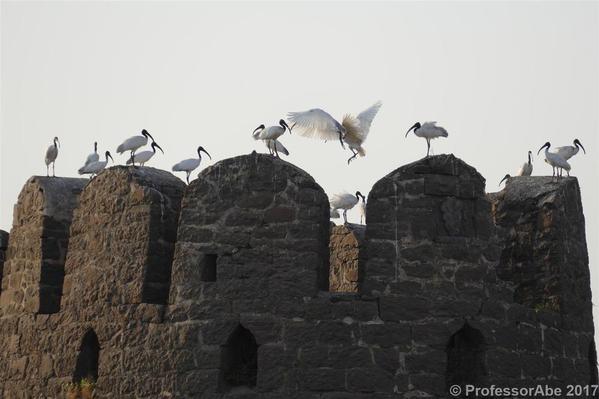
In contrast to the one in Bijapur, this small hotel was very friendly and served excellent food. Dinner was very nice and the breakfast the next morning a veritable feast. The photo shows only part of it.

To be continued with pt.6: Bidar and Hyderabad










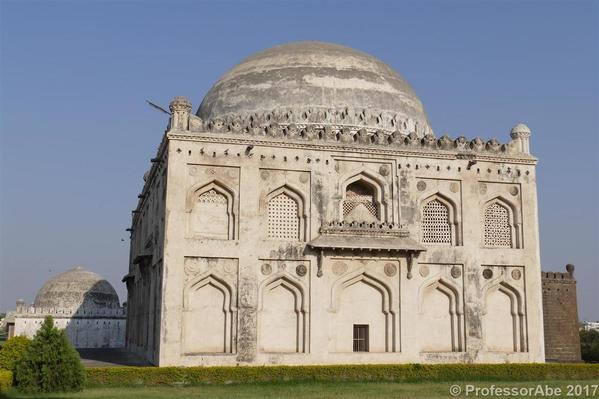

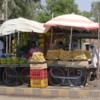

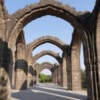
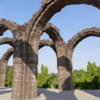


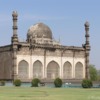


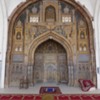
















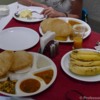
Comments (1)